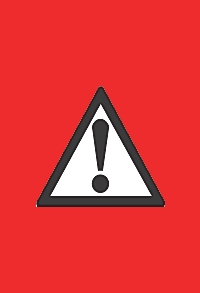 |
DO NOT EXCEED RATED PRESSURESUnder normal operation, do not expose any portion of the LP-Gas system to pressures in excess of rated working pressures without an automatic safety valve to vent the over pressure discharge to a place of safety away from the operator and other people. Failure to provide such a safety relief may result in leakage or rupture of one or more of the components in the system. This can result in injury or death from the gas, a fire, or pieces of flying debris from the rupture.
When a back-check valve is used, an automatic safety valve must be installed to prevent pressure buildup (thermal expansion) in excess of rated working pressure in the meter housing. One automatic safety valve should be installed in each meter. Remove the pipe plug from the front cover or rear cover and insert the appropriate automatic safety valve. |
Ensure that you are mindful of the following when operating your meter:
•THE METER MUST REMAIN FULL OF PRODUCT AT ALL TIMES – An easy way to accomplish this is to put the meter assembly in the line below the piping center-line (a sumped position). This requires adding elbows and flanges prior to installing the meter. The meter should be installed in a bypass loop, below the pipe center-line, with block valves upstream and downstream of the meter inside the bypass loop. A block valve should be located in the main pipeline and labeled as the bypass valve.
•PIPING PRESSURE RELIEF – Any portion of pipe system that might isolate or block flow should be provided with a pressure relief to prevent damage from thermal expansion. There are excellent benefits to this type of installation. First, the meter is kept full. Second, this type of installation allows the meter to be isolated for servicing and calibration while continuing flow through the bypass valve.
•MAINTAIN UPSTREAM LINES – Upstream lines must be maintained full to prevent air from entering the meter. If upstream or inlet lines are constructed in a manner which allows reverse flow, foot valves, or back checks must be installed.
•UNDERGROUND TANKS, SUBMERSIBLE PUMPS – Underground tanks that are furnished with a submersible pump will eliminate many problems that occur with positive displacement pumps (suction pumps) when suction piping is incorrectly sized or when the lift is too great.
•EVERY METER SHOULD BE CALIBRATED – Every meter should be calibrated under actual service and installation conditions per the API Manual of Petroleum Measurement Standards:
The following chapters of the API Manual of Petroleum Measurement supersedes the API standard 1101:
- Chapter 4 - Proving Systems
- Chapter 5 - Metering
- Chapter 6 - Metering Assemblies
- Chapter 11 Section 2.3 - Water Calibration of Volumetric Provers
- Chapter 12 Section 2 - Calculation of Petroleum Quantities
•PROVIDE A MEANS OF CONVENIENTLY DIVERTING LIQUID FOR CALIBRATION PURPOSES
•EVALUATE PUMPING EQUIPMENT – Give careful attention to the pumping equipment and piping in your system. Because of their influence on liquid being measured as it enters the metering assembly, systems should be made free of conditions that cause or introduce entrained air or vapor.
•FOLLOW THE MANUFACTURER’S RECOMMENDATION FULLY WHEN INSTALLING PUMPS – Give particular attention to factors like: use of foot valves, pipe size to the inlet, and conformance to net positive suction head (NPSH) conditions when suction pumping is required. Follow manufacturer recommendations to minimize air and vapor elimination problems.
•LIGHT HYDROCARBONS AND SIMILAR LIQUIDS – For liquids such as light hydrocarbons that tend to flash or vaporize easily at higher ambient temperatures, it is advantageous to use flooded suctions and piping sized larger than the nominal pump size.
•VEHICLE TANK INSTALLATIONS – On vehicle tank installations, the layout of the system’s piping is crucial in preventing problems with split compartment test conformance. Piping should slope away from a positive displacement pump to prevent resurgent re-priming of the pump due to drain back.
•AVOID HYDRAULIC SHOCK – Hydraulic shock is harmful to all the components of an operating system, including the valves, the meter, and the pump. Because of the high precision with which they measure products, meters, in particular, must be protected against hydraulic shock. The best protection against hydraulic shock is to prevent it from occurring. To prevent hydraulic shock, adjust the closing rate of the valve until shock does not occur.
•AVOID THERMAL EXPANSION – Thermal expansion, like hydraulic shock, can easily damage meters and other components in the system. When designing the system, include pressure relief valves in any portion or branch of the system that might be closed off when an operating or block valve is closed.